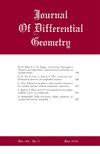On number and evenness of solutions of the $SU(3)$ Toda system on flat tori with non-critical parameters
IF 1.3
1区 数学
Q1 MATHEMATICS
引用次数: 2
Abstract
We study the $SU(3)$ Toda system with singular sources \begin{equation*} \begin{cases} \Delta u+2e^{u}-e^{v}=4\pi \sum _{k=0}^{m} n_{1,k}\delta _{p_{k}} \quad \text{ on }\; E_{\tau}, \\ \Delta v+2e^{v}-e^{u}=4\pi \sum _{k=0}^{m} n_{2,k}\delta _{p_{k}} \quad \text{ on }\; E_{\tau}, \end{cases} \end{equation*} where $E_{\tau}:=\mathbb{C}/(\mathbb{Z}+\mathbb{Z}\tau )$ with $\operatorname{Im}\tau \gt 0$ is a flat torus, $\delta _{p_{k}}$ is the Dirac measure at $p_{k}$, and $n_{i,k}\in \mathbb{Z}_{\geq 0}$ satisfy $\sum _{k}n_{1,k}\not \equiv \sum _{k} n_{2,k} \mod 3$. This is known as the non-critical case and it follows from a general existence result of [$\href{ https://doi.org/10.1016/j.aim.2015.07.036}{3}$] that solutions always exist. In this paper we prove that (i) The system has at most \begin{equation*} \frac{1}{3\times 2^{m+1}}\prod _{k=0}^{m}(n_{1,k}+1)(n_{2,k}+1)(n_{1,k}+n_{2,k}+2) \in \mathbb{N} \end{equation*} solutions. We have several examples to indicate that this upper bound should be sharp. Our proof presents a nice combination of the apriori estimates from analysis and the classical Bézout theorem from algebraic geometry. (ii) For $m=0$ and $p_{0}=0$, the system has even solutions if and only if at least one of $\{n_{1,0}, n_{2,0}\}$ is even. Furthermore, if $n_{1,0}$ is odd, $n_{2,0}$ is even and $n_{1,0}\lt n_{2,0}$, then except for finitely many $\tau $’s modulo $SL(2,\mathbb{Z})$ action, the system has exactly $\frac{n_{1,0}+1}{2}$ even solutions. Differently from [$\href{ https://doi.org/10.1016/j.aim.2015.07.036}{3}$], our proofs are based on the integrability of the Toda system, and also imply a general non-existence result for even solutions of the Toda system with four singular sources.非关键参数平面环面上$SU(3)$ Toda系统解的数量和偶数性
我们研究了具有奇异源的$SU(3)$ Toda系统\begin{equation*} \begin{cases} \Delta u+2e^{u}-e^{v}=4\pi \sum _{k=0}^{m} n_{1,k}\delta _{p_{k}} \quad \text{ on }\; E_{\tau}, \\ \Delta v+2e^{v}-e^{u}=4\pi \sum _{k=0}^{m} n_{2,k}\delta _{p_{k}} \quad \text{ on }\; E_{\tau}, \end{cases} \end{equation*},其中$E_{\tau}:=\mathbb{C}/(\mathbb{Z}+\mathbb{Z}\tau )$和$\operatorname{Im}\tau \gt 0$是一个平面环面,$\delta _{p_{k}}$是在$p_{k}$处的狄拉克测度,$n_{i,k}\in \mathbb{Z}_{\geq 0}$满足$\sum _{k}n_{1,k}\not \equiv \sum _{k} n_{2,k} \mod 3$。这就是所谓的非临界情况,它由[$\href{ https://doi.org/10.1016/j.aim.2015.07.036}{3}$]的一般存在性结果得出,解总是存在的。本文证明了(i)系统最多有\begin{equation*} \frac{1}{3\times 2^{m+1}}\prod _{k=0}^{m}(n_{1,k}+1)(n_{2,k}+1)(n_{1,k}+n_{2,k}+2) \in \mathbb{N} \end{equation*}个解。我们有几个例子表明这个上界应该是尖锐的。我们的证明很好地结合了分析中的先验估计和代数几何中的经典bsamzout定理。(ii)对于$m=0$和$p_{0}=0$,系统有偶解当且仅当$\{n_{1,0}, n_{2,0}\}$中至少有一个是偶解。进一步,如果$n_{1,0}$为奇数,$n_{2,0}$为偶数,$n_{1,0}\lt n_{2,0}$,则除了$\tau $的模$SL(2,\mathbb{Z})$作用有限个外,系统恰好有$\frac{n_{1,0}+1}{2}$个偶解。与[$\href{ https://doi.org/10.1016/j.aim.2015.07.036}{3}$]不同的是,我们的证明是基于Toda系统的可积性,并且还隐含了Toda系统的四个奇异源偶解的一般不存在性结果。
本文章由计算机程序翻译,如有差异,请以英文原文为准。
求助全文
约1分钟内获得全文
求助全文
来源期刊
CiteScore
3.40
自引率
0.00%
发文量
24
审稿时长
>12 weeks
期刊介绍:
Publishes the latest research in differential geometry and related areas of differential equations, mathematical physics, algebraic geometry, and geometric topology.

 求助内容:
求助内容: 应助结果提醒方式:
应助结果提醒方式:


